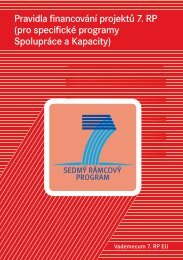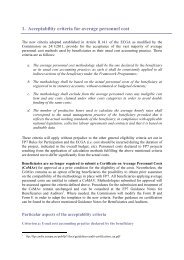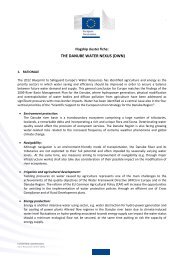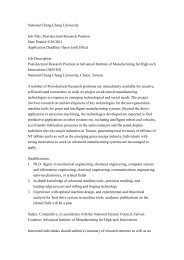Guide to Research and Innovation Strategies for Smart Specialisation
Guide to Research and Innovation Strategies for Smart Specialisation
Guide to Research and Innovation Strategies for Smart Specialisation
You also want an ePaper? Increase the reach of your titles
YUMPU automatically turns print PDFs into web optimized ePapers that Google loves.
Developing a RIS3 involves a degree of risk-taking, since there is always some uncertainty in<br />
the choice of priorities, on the events that can change the region’s growth trajec<strong>to</strong>ry, <strong>and</strong> on<br />
the best way <strong>to</strong> implement actions in support <strong>for</strong> regional smart specialisation. Hence<br />
experimentation is justified, <strong>and</strong> even recommended, <strong>to</strong> test new approaches or gain more<br />
in<strong>for</strong>mation <strong>and</strong> certainty on the prospects of the priorities selected <strong>for</strong> the RIS3.<br />
This can take the <strong>for</strong>m of pilot projects <strong>to</strong> be launched during the RIS3 design process. These<br />
pilot projects should be selected according <strong>to</strong> two main criteria: their relevance with respect <strong>to</strong><br />
the RIS3 priorities; <strong>and</strong> their expected impacts in short or medium term (projects with longer<br />
term impacts are valuable but would not feed the demonstration purpose of pilot projects).<br />
Pilot projects serve the following functions:<br />
• Feeding the strategy with new in<strong>for</strong>mation on regional innovation potential (they<br />
participate <strong>to</strong> the 'entrepreneurial discovery process');<br />
• Providing a signal <strong>to</strong> underline the fact that the strategy is going <strong>to</strong> be concretely<br />
implemented rather than remaining a concept; contributing <strong>to</strong> the communication of the<br />
RIS3 as a whole;<br />
• Testing new or unconventional policy support approaches on a small scale be<strong>for</strong>e<br />
possible extension, limiting risk.<br />
Even more than <strong>for</strong> conventional projects <strong>and</strong> actions, pilot projects need <strong>to</strong> be moni<strong>to</strong>red <strong>and</strong><br />
evaluated, in order <strong>to</strong> found the decision on continuation <strong>and</strong> discontinuation of the projects<br />
on reliable evidence. Exit strategies <strong>and</strong> intermediary miles<strong>to</strong>nes involving go/no go decisions<br />
need <strong>to</strong> be built in<strong>to</strong> the pilot projects.<br />
If such learning mechanisms are properly introduced in pilot projects, they can provide a<br />
model <strong>for</strong> per<strong>for</strong>mance-based funding mechanisms, which are no<strong>to</strong>riously difficult <strong>to</strong> impose<br />
on existing programmes or actions maintained over time without such a provision.<br />
59

















